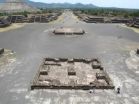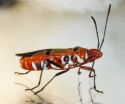(Press-News.org) In collaboration with the National University of Mexico, a team of Spanish researchers has analysed for the first time remains of cosmetics in the graves of prehispanic civilisations on the American continent. In the case of the Teotihuacans, these cosmetics were used as part of the after-death ritual to honour their city's most important people.
A research team from the Polytechnic University of Valencia and the University of Valencia has studied various funerary samples found in urns in the Teotihuacan archaeological site (Mexico) that date from between 200 and 500 AD.
The scientists have been researching Mayan wall paintings in Mexico and Guatemala since 2006. Published in the 'Journal of Archaeological Science', this project came about after contact on various occasions with other researchers in the area, namely the National University of Mexico, who wanted to know the composition and function of the cosmetics found in pots.
"The conclusion that we have reached, given the structure of the pigments found, is that they are remains of cosmetics that were used in rituals following burial. At that time it was common to periodically practice a kind of remembrance worship of the deceased high nobility," as explained to SINC by María Teresa Domenech Carbo, director of the University Institute of Heritage Restoration of the Polytechnic University of Valencia and lead author of the study.
In these rituals the high priest of the city would conduct a ceremony in the dwelling of the most noble of citizens (nobility, princes and kings). The reason for this is that unlike today where graves are located in special places, in those days the deceased were buried underneath the floor of their homes.
"The priest would go to the home and would pay homage to the deceased with the family present. Cosmetics were used by the priest carrying out the ceremony and formed a part of the ritual. The remains of carbonaceous particles found lead to the belief that aromatic material were burnt, with the priest painting parts of the body with those pigments. In addition, it is probable that the body was removed and 'redecorated' too," explains Domenech.
Furthermore, the researchers outline that although we could think that these materials in the urns belonged to the deceased in life and were put in the grave to accompany their owner into the 'new life', as in the case of the Egyptians, the fact that the make-up did not contain any agglutinative substance (an organic vehicle that allows make-up to stick to the face or body) leads us to believe that they had more of a symbolic nature.
"It is not very frequent to find cosmetic products in archaeological excavations in America. These are the first on this continent to be analysed in a serious and systematic way," ensures the researcher. In Europe and Africa, mainly in countries such as Italy and Egypt, the analysis of cosmetic products is more common.
Teotihuacan is one of the most important and most visited archaeological sites in Mexico thanks to its close location to Mexico City and its spectacular great Mayan pyramid.
Flowing trade in Prehispanic Mexico
As well as providing more knowledge on the funerary rituals of this millennium-old culture, the cosmetic remains found help us to identify the social relevance of the buried individuals and they prove the existence of fluid commerce between the different areas of Mexico.
The scientists found material coming from the surroundings of Teotihuacan, such as pulverised volcanic rock pigments and other clay-like types typical of the area's geology.
Nonetheless, some remains, such as those mica and jarosite particles found, are not native to the surroundings and were probably imported from different parts of Mexico. This, in turn, confirms the existence of trade. "No surprise since this city dominated the entire Mesoamerican region and it has been shown that fluid trade existed in certain southern areas," points out the researcher.
In addition, the appearance of these remains with the body of the deceased indicates their social status. "Unless the person was very important to this civilisation they were not buried with cosmetic products. The deceased would have had to hold an important position in society, such as that of a king, a prince or a high noble," ensures the expert.
Following this study, the research team analysed another collection of cosmetic material in the region of Guatemala. The results are currently awaiting publication.
INFORMATION:
References:
María Teresa Doménech-Carbó, María Luisa Vázquez de Agredos-Pascual, Laura Osete-Cortina, Antonio Doménech-Carbó , Núria Guasch-Ferré , Linda R. Manzanilla , Cristina Vidal-Lorenzo. "Characterization of prehispanic cosmetics found in a burial of the ancient city of Teotihuacan (Mexico)" Journal of Archaeological Science 39: 1043 – 1062, 2012.
The Teotihuacans exhumed their dead and dignified them with make-up
2013-01-09
ELSE PRESS RELEASES FROM THIS DATE:
R U eating healthy 2day?
2013-01-09
AUDIO:
Melanie Hingle, Ph.D., MPH, RD, University of Arizona, discusses the effectiveness of using text messaging to engage adolescents in ‘‘conversations’’ about health using a familiar communication method -- that is...
Click here for more information.
Philadelphia, PA, January 9, 2013 – According to the Nielsen consumer research group, teens receive an average of 3,417 text messages per month (that's 114 texts per day!). Couple this with CDC's report that high school students' ...
Making whole wheat bread taste and smell more appetizing
2013-01-09
The key to giving whole wheat bread a more appetizing aroma and taste may lie in controlling the amounts of a single chemical compound that appears in the bread, which nutritionists regard as more healthful than its refined white counterpart. That's the finding of a new study in ACS' Journal of Agricultural and Food Chemistry, which opens the door to making whole wheat bakery products more appealing to millions of people.
Devin G. Peterson and colleagues explain that whole wheat flour includes all three layers of the grain — bran, germ and endosperm — while refined flour ...
Chemical modules that mimic predator-prey and other behaviors
2013-01-09
Scientists are reporting development of chemical modules that can reproduce, on an "unprecedented" molecular level, changes and interactions that occur in natural populations of plants and animals, including those of hunting and being hunted for food, conducting mutually beneficial relationships and competing for resources. The report on these new "predator-prey biochemical oscillators," which could become building blocks for molecular machines and computers, appears in ACS Nano.
Yannick Rondelez and Teruo Fujii explain that just as plants and animals interact in complex ...
Bugs need symbiotic bacteria to exploit plant seeds
2013-01-09
This press release is available in German.
Aggregations of the red and black colored firebugs are ubiquitous under linden trees in Central Europe, where the bugs can reach astounding population densities. While these insects have no impact on humans, their African, Asian, and American relatives, the cotton stainers, are serious agricultural pests of cotton and other Malvaceous plants. Researchers at the Max Planck Institute for Chemical Ecology in Jena, Germany, recently discovered that these bugs need bacterial symbionts to survive on cotton seeds as their sole food source. ...
Used coffee grounds are a rich source of healthful antioxidants
2013-01-09
To plant food, insect repellant and other homespun uses for spent coffee grounds, scientists are adding an application that could make the gunk left over from brewing coffee a valuable resource for production of dietary supplements. Their new report in ACS' Journal of Agricultural and Food Chemistry concludes that used coffee grounds are a rich source of healthful antioxidant substances.
Maria-Paz de Peña and colleagues explain that people around the world drink millions of cups of coffee every day, generating about 20 million tons of used grounds annually. Although some ...
Expert suggests tried-and-true strategies to strengthen your relationship
2013-01-09
URBANA – What are you doing to keep your relationship alive? A University of Illinois study highlights the importance of five relationship maintenance strategies that couples can use to preserve or improve the quality of an intimate relationship.
"Relationships are like cars in that you have do certain things to keep them running, especially when your goal is to strengthen and preserve your bond with your partner," said Brian Ogolsky, a U of I professor of human and community development.
To determine which factors are the most important in promoting healthy relationships, ...
News from the world of quantum physics: A non-causal quantum eraser
2013-01-09
This press release is available in German.
Whether a quantum object behaves like a wave or like a particle depends (according to the Copenhagen interpretation) on the choice of measurement apparatus used for observing the system, and therefore on the type of measurement performed.
Anton Zeilinger's team of physicists at the University of Vienna and the Austrian Academy of Sciences has recently taken this phenomenon further than ever. Whether a certain photon behaves like a particle or like a wave depends on the measurement performed on a second photon. In the ...
Supply problems spark search for new ways to make magnets -- not the 'fridge' variety
2013-01-09
Mention magnets, and most people think of trivial applications of those pieces of metal, like holding family photos and reminder notes on the refrigerator. An article on magnets in the current edition of Chemical & Engineering News (C&EN), however, focuses on the critical role magnets play in the real world and the search for new materials to make them. C&EN is the weekly newsmagazine of the American Chemical Society, the world's largest scientific society.
In the article, C&EN Senior Correspondent Mitch Jacoby explains that magnets are crucial to an enormous number of ...
Why are children at higher risk for negative health effects of environmental toxins?
2013-01-09
New Rochelle, NY, January 9, 2013—More than 85,000 synthetic chemicals are registered for commercial use with the U.S. Environmental Protection Agency (EPA), and only about half of those produced in large quantities are tested for their potential toxic effects on humans. Children are particularly vulnerable to environmental toxins and a detailed look at how and why, and what can be done to protect children's health, is presented in a two-part article published in Alternative and Complementary Therapies from Mary Ann Liebert, Inc., publishers. The articles are available ...
Tree seeds offer potential for sustainable biofuels
2013-01-09
Tree seeds, rather than biomass or fuel crop plants, could represent an abundant source of renewable energy, according to research published in the International Journal of Automotive Technology and Management. The study suggests that seeds from the Indian mahua and sal trees have almost as good a thermal efficiency as biodiesel but would produce lower emissions of carbon monoxide, waste hydrocarbons and NOx (nitrogen oxides).
Sukumar Puhan of the GKM College of Engineering and Technology and colleagues N. Vedaraman and K.C. Velappan of the Central Leather Research Institute, ...



